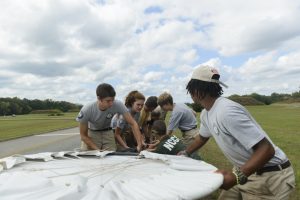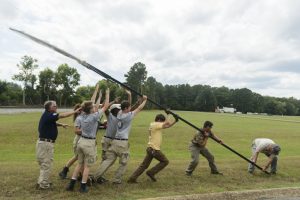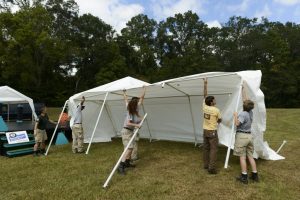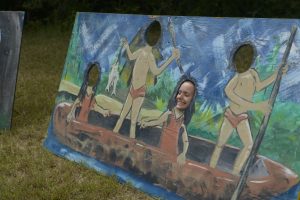
TUSCALOOSA, Ala. — The University of Alabama’s Moundville Native American Festival is more than just an event for the hundreds of people who participate each year. To these volunteers, staff and performers, it’s a family homecoming.
“Even though it’s crowded, we all know one another because we’ve been doing this event for the last 27 years,” said Betsy Irwin, interim director at Moundville Archaeological Park and festival director.
“We have little groupings – the flintknappers over in one spot, the living historians in another, some of the different tribal members camping in another nook. I call it the festival family. I’ve watched my children and the children of many of my close friends grow up at the festival.”
Like most large “homecoming” events, the Moundville Native American Festival, which this year runs Oct. 7-10, is one that requires months of planning and hundreds of volunteers to ensure its success. Now in its 27th year, festival staff and volunteers have nearly perfected that planning process.
Active festival planning begins as early as April. Participation is by invitation only; any new participants must go through an application process and submit pictures of their work and their booth or set up.
The festival committee scouts out performers, oftentimes recruiting from other high quality events like the Santa Fe Indian Arts Market, Oakville Indian Mounds Southeastern Indian Festival and Oakmulgee National Park Indian Celebration.

There are two different performance schedules — one for Wednesday and Thursday when the majority of festival visitors are school groups, and another for Friday and Saturday. The bigger name musicians are brought in on Friday.
While most of the performers are the same, Irwin said they try to feature at least one new act each year, and they also have at least one group that has won a Native American Music Award.
The most popular stage performer by far is Lyndon Alec, a hoop dancer.
“We have lots of teachers that have come to the festival for years and the bleachers are always packed for him,” Irwin said.
In total, there are three flutists, the four-member band Injunuity, singer/song writer/guitarist Pura Fe Crescioni, two dance troupes (Chickasha Hithla and the Mystic Wind Choctaw Dancers), one hoop dancer, two storytellers and 13 living history presenters.
But the festival is more than just stage performances. There are also 35 to 40 craft vendors, five to 10 fine artists and 12 craft demonstrations. These vendors go through numerous supplies, including leather, sinew, beads, gems, rocks and minerals, wood, shell, copper, pearls, silver, cloth, ribbons, wire, feathers, thread and cordage and paint and pigments.
And a festival wouldn’t be a festival without food. There are 10 to 12 food and concessions vendors, including three Native American food vendors, available for festival attendees. A huge generator is used to provide power to the food vendors, as well as several hundred feet of hose and at least six hose splitters to get running water to each of the booths, Irwin said.

But it’s not just festival attendees that need to be fed. Irwin said they offer breakfast to all staff, volunteers and festival participants every morning.
All presenters, a total of 175 people on Wednesday and Thursday and 250 on Friday and Saturday, receive lunch, as well. In addition to food, they go through 1,800 to 2,500 bottles of water, and they start off with 200 20-pound bags of ice.
With less than $100,000 to fund the entire event, the festival relies heavily on donations.
During the festival, Hale County EMTs, the Moundville Police Department and nursing students from the Virginia College of Nursing in Birmingham are on hand to help with any medical needs that may arise.
The nursing students periodically check the blood pressure and blood sugar levels of the elderly and Native American participants; diabetes and high blood pressure are the two most common medical conditions among native folks, Irwin said.
Now, with a general picture in mind of what happens during the festival’s four days, try to imagine how long it might take to have the park ready for an event of this magnitude.
“Three weeks,” Irwin said. “It takes three weeks to get everything set up and ready to go for the festival.”
This is typically done with the help of park staff and volunteers. Last year, 231 volunteers committed 1,059 hours to the festival. While there are still plenty of volunteers helping with this year’s event, a team with the National Civilian Community Corps, an AmeriCorps program, also helped.
During the three-weeklong project, the team is erecting more than 20 tents of various sizes, at least 15 arbors around the park, putting together a custom-built stage, as well as other park-related projects.

Of course, tear down is nothing like set-up.
“Breaking down the festival is always easier than putting it up,” Irwin said. “We don’t have a deadline so we get everything that might be damaged by bad weather put up first and then work our way through the rest of it. Sometimes it takes three weeks, sometimes a little longer.”
Once everything is cleaned, inventoried and stored, park staff can rest easy — at least for a few days.
Despite the exhaustion that comes from months of planning and hard work, Irwin couldn’t imagine not being involved.
The purpose of the Moundville Native American Festival is not just to offer another event or show children how to play stickball. The goal has always been to spark an understanding of what once was, and now is, Southeastern Indian culture.
“Reframing how people stereotype Native people is in the top of most everyone’s mind that helps to put on or who works at the festival,” Irwin said. “Our minds tend to create static images and conceptions of humans that are different from how we classify ourselves.
“On its most basic level, what I wish visitors would get out of the Native American Festival is that we are all human beings,” Irwin said. “We need to focus on our similarities, not our differences, to overcome the prejudice and hatred that drives so much violence and misunderstanding today.”
A Native American Homecoming will be open from 9 a.m. to 3:30 p.m. Wednesday and Thursday, Oct. 7 and 8, and 9 a.m. to 5 p.m. Friday and Saturday, Oct. 9 and 10. Admission to the festival is $12 for adults; $10 for seniors; $8 for students; and free for children ages 5 and younger.
Group discounts with reservations are available. For more information, or to make group reservations, phone 205/371-2234.